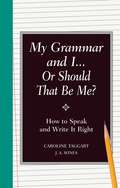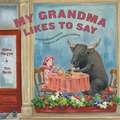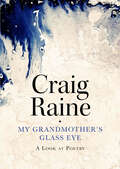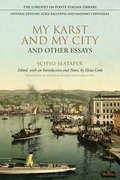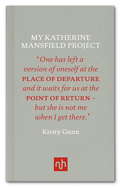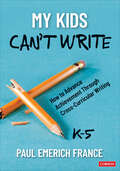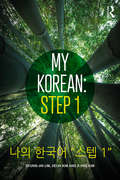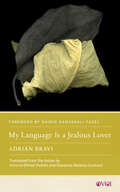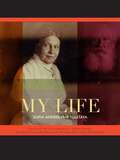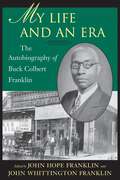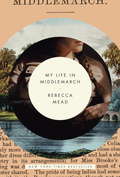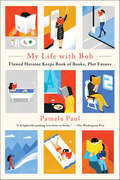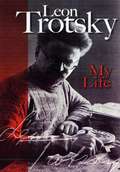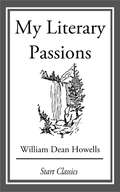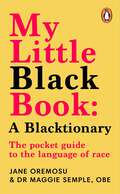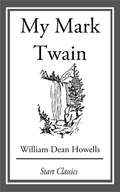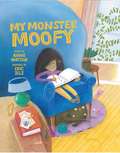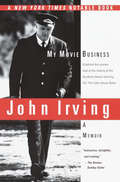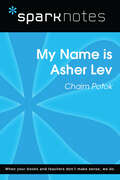- Table View
- List View
My Grammar and I Or Should That Be Me?
by J. A. WinesSharpen your language skills and navigate your way around grammatical minefields with this entertaining and practical guide. For anyone who has ever been stumped by dangling modifiers and split infinitives, or for those who have no idea what these things even are, My Grammar and I...Or Should That Be Me? offers practical and humorous guidance on how to avoid falling into language pitfalls. Here are all the right tools to help you gain confidence as a speaker and writer, highlighting the most common language errors, such as wrongly used prepositions, misplaced modifiers, and confusing participles. This refreshing refresher course covers: ? Spelling and Confusables-There are times when the spelling rule "i before e except after c" does not apply ? Parts of Speech-Is it "its" or "it's"? "Whose" or "who's"? ? Sentence Structure-Let us ponder the subject, or object, of "I" and "me" ? Punctuation-So where does a comma go? ? Elements of Style-There is more to grammar than knowing the difference between a subordinate object and a nonrestrictive apostrophe And, for those grammar know-it-alls, there are entertaining "Smart Aleck" trivia, anecdotes, witticisms, and more. Clever and informative, this is the ideal gift for all English-language sticklers.
My Grandma Likes to Say
by Denise Brennan-NelsonMy Grandma Likes to Say What visual comes to your mind when you hear, "Fly by the seat of your pants," or "A rolling stone gathers no moss," or "Throw caution to the wind"? My Grandma Likes to Say is a child's hilarious visual interpretation of the sayings that grandmas, nanas, gigias, omas, grannies, grandmamas, grand-mères, abuelas, or ya-yas sprinkle throughout their language. Idioms, maxims, proverbs, and clichés have been around for many years. While they can be confusing, especially to young ears, once understood they can be an excellent example of the power of language. Following the runaway success of My Momma Likes to Say and My Teacher Likes to Say, award-winning author Denise Brennan-Nelson is once again paired with award-winning illustrator Jane Monroe Donovan to bring you the fun and downright silliness of these expressions from a child's point of view.
My Grandmother's Glass Eye: A Look at Poetry
by Craig RaineFrom critic and poet Craig Raine comes a fresh, bold examination of the meaning of poetry and some of the great poetical works of our time"By poetry we—we the masses—mean something vague, something untrue, something uplifting, something beautiful, something so eloquent it isn't for everyday. The word "poetry" is up there with "soul". And I am against it.'Craig Raine's new work of criticism deploys its considerable learning, its intelligent expertise, lightly, wittily, memorably. It is an exercise in demystification and clarity. If you want to know how poetry works on the page, here are sure-footed accounts of particular poems. There is something Johnsonian in Craig Raine's common sense—an elegant wrecking ball used with precision and delicacy to pick off the pretentious, the platitudinous, the over-promoted. Here, poetry is well read, attentively read, by a practitioner whose range runs from Bion to John Lennon, from Bishop to Balanchine.
My Havana
by Xenia Reloba de la Cruz Maria Carida Cumana Karen DubinskyFor more than thirty years, musician Carlos Varela has been a guide to the heart, soul, and sound of Havana. One of the best known singer-songwriters to emerge out of the Cuban nueva trova movement, Varela has toured in North America, the Caribbean, Latin America, and Europe. In North America, Varela is "Cuba's Bob Dylan." In Cuba, he is the voice of the generation that came of age in the 1990s and for whom his songs are their generation's anthems. My Havana is a lyrical exploration of Varela's life and work, and of the vibrant musical, literary, and cinematic culture of his generation.Popular both among Cubans on the island and in the diaspora, Varela is legendary for the intense political honesty of lyrics. He is one of the most important musicians in the Cuban scene today. In My Havana, writers living in Canada, Cuba, the United States, and Great Britain use Varela's life and music to explore the history and cultural politics of contemporary Cuba. The book also contains an extended interview with Varela and English translations of the lyrics to all his recorded songs, most of which are appearing in print for the very first time.
My Ideal Bookshelf
by Jane Mount Thessaly La ForceThe books that we choose to keep --let alone read-- can say a lot about who we are and how we see ourselves. In MY IDEAL BOOKSHELF, dozens of leading cultural figures share the books that matter to them most; books that define their dreams and ambitions and in many cases helped them find their way in the world. Contributors include Malcolm Gladwell, Thomas Keller, Michael Chabon, Alice Waters, James Patterson, Maira Kalman, Judd Apatow, Chuck Klosterman, Miranda July, Alex Ross, Nancy Pearl, David Chang, Patti Smith, Jennifer Egan, and Dave Eggers, among many others. With colorful and endearingly hand-rendered images of book spines by Jane Mount, and first-person commentary from all the contributors, this is a perfect gift for avid readers, writers, and all who have known the influence of a great book.
My Karst and My City and Other Essays (Lorenzo Da Ponte Italian Library)
by Scipio SlataperScipio Slataper is one of the most prominent writers from the Italian town of Trieste. Before the onslaught of World War One, Trieste was a unique urban environment and the largest port in the Austro-Hungarian Empire. It was a financially powerful city and a cosmopolitan centre where Slavic, Germanic, and Italian cultures intersected. Much of Slataper’s oeuvre is highly influenced by Trieste’s cultural complexity and its multi-ethnic environment. Slataper’s major literary achievement, My Karst and My City – a fictionalized, lyrical autobiography, translated here in its entirety – offers a unique example of an Italian modernist narrative, one that is influenced both by Slataper’s collaboration with the Florentine journal La Voce, and by the Germanic and Scandinavian literature that he absorbed while living in Trieste. My Karst and My City, together with the excerpts from his reflections on Ibsen and other critical essays included here, adds a new voice and a different dimension to our understanding of European modernism.
My Katherine Mansfield Project
by Kirsty GunnIn 2009, Kirsty Gunn returned to spend the winter in her hometown of Wellington, New Zealand, also the place where Katherine Mansfield grew up. In this exquisitely written "notebook," which blends memoir, biography, and essay, Gunn records that winter-long experience and the unparalleled insight it allowed her into Mansfield's fiction. Gunn explores the idea of home and belonging--and of the profound influence of Mansfield's work on her own creative journey. She asks whether it is even possible to "come home"--and who are we when we get there?
My Kids Can′t Write, K-5: How to Advance Achievement Through Cross-Curricular Writing
by Paul Emerich FrancePractical and sustainable writing practice in every classroom Teachers consistently grapple with how to make writing fun and engaging. While long-form writing has its value, research shows that balancing genre-based units with frequent, on-demand writing tasks to help children communicate effectively and reflect on their learning might be the key to success. My Kids Can′t Write provides sustainable and scalable practices for writing across all content areas and shows teachers how to develop structures and rituals for sustaining a journal-based approach to instruction and assessment in classrooms. Inside, you′ll find Scaffolds and strategies that systematically support students in strengthening their skills while simultaneously writing to learn Ways to embed foundational skills like spelling and grammar to help students become stronger communicators The purpose of cognitive writing and how to properly set up journaling within the classroom Numerous student journal samples and informative vignettes Now is the time to embed writing into all subjects and emphasize accurately interpreting information, effectively communicating needs, and making learning visible to students and educators alike.
My Kids Can′t Write, K-5: How to Advance Achievement Through Cross-Curricular Writing
by Paul Emerich FrancePractical and sustainable writing practice in every classroom Teachers consistently grapple with how to make writing fun and engaging. While long-form writing has its value, research shows that balancing genre-based units with frequent, on-demand writing tasks to help children communicate effectively and reflect on their learning might be the key to success. My Kids Can′t Write provides sustainable and scalable practices for writing across all content areas and shows teachers how to develop structures and rituals for sustaining a journal-based approach to instruction and assessment in classrooms. Inside, you′ll find Scaffolds and strategies that systematically support students in strengthening their skills while simultaneously writing to learn Ways to embed foundational skills like spelling and grammar to help students become stronger communicators The purpose of cognitive writing and how to properly set up journaling within the classroom Numerous student journal samples and informative vignettes Now is the time to embed writing into all subjects and emphasize accurately interpreting information, effectively communicating needs, and making learning visible to students and educators alike.
My Korean: 나의 한국어 “스텝 1”
by Jieun Kim Ji-Hye Kim Byung-jin LimThe My Korean series of textbooks offers a learner-centred, communicative task-based, interactive approach to learning contemporary Korean. My Korean: Step 1 and My Korean: Step 2 are arranged thematically around topics that any novice learner of Korean is likely to encounter in their first year of study. Each lesson contains two dialogues showing contemporary Korean in use, followed by succinct grammar and vocabulary explanations. The focus throughout the books is on communicative in-class activities and tasks that encourage students’ active participation. Video clips of the lesson dialogues are available as an online resource, and each unit contains communicative activities based on the dialogue themes. The engaging structure and communicative approach make My Korean: Step 1 an ideal text for first semester Korean courses. It is also a great resource for individual study or one-on-one tutorials on Korean language and culture.
My Language Is a Jealous Lover (Other Voices of Italy)
by Adrián N. BraviMany great writers have been fluent in multiple languages but have never been able to escape their mother tongue. Yet if a native language feels like home, an adopted language sometimes offers a hospitality one cannot find elsewhere. My Language Is a Jealous Lover explores the plights and successes of authors who lived and wrote in languages other than their mother tongue, from Samuel Beckett and Vladimir Nabokov to Ágota Kristóf and Joseph Brodsky. Author Adrián N. Bravi weaves their stories in with his own experiences as an Argentinian-Italian, thinking and writing in the language of his new life while recalling that of his childhood. Bravi bears witness to the frustrations, the soul-searching, the pain, and the joys of embracing another language.
My Life
by Sofia Andreevna TolstayaOne hundred years after his death, Leo Tolstoy continues to be regarded as one of the world’s most accomplished writers. Historically, little attention has been paid to his wife Sofia Andreevna Tolstaya. Acting in the capacity of literary assistant, translator, transcriber, and editor, she played an important role in the development of her husband’s career. Her memoirs – which she titled My Life – lay dormant for almost a century. Now their first-time-ever appearance in Russia is complemented by an unabridged and annotated English translation. Tolstaya’s story takes us from her childhood through the early years of her marriage, the writing of War and Peace and Anna Karenina and into the first year of the twentieth century. She paints an intimate and honest portrait of her husband’s character, providing new details about his life to which she alone was privy. She offers a better understanding of Tolstoy’s character, his qualities and failings as a husband and a father, and forms a picture of the quintessential Tolstoyan character which underlies his fiction. My Life also reveals that Tolstaya was an accomplished author in her own right—as well as a translator, amateur artist, musician, photographer, and businesswoman—a rarity in the largely male-dominated world of the time. She was actively involved in the relief efforts for the 1891–92 famine and the emigration of the Doukhobors in 1899. She was a prolific correspondent, in touch with many prominent figures in Russian and Western society. Guests in her home ranged from peasants to princes, from anarchists to artists, from composers to philosophers. Her descriptions of these personalities read as a chronicle of the times, affording a unique portrait of late-19th- and early-20th-century Russian society, ranging from peasants to the Tsar himself. My Life is the most important primary document about Tolstoy to be published in many years and a unique and intimate portrait of one of the greatest literary minds of all time.The Modern Language Association (MLA) awarded the Lois Roth Award to John Woodsworth and Arkadi Klioutchanski of the University of Ottawa’s Slavic Research Group for their translation of Sofia Andreevna Tolstaya’s My Life memoirs. My Life was selected among the top 100 non-fiction works of 2010 by The Globe and Mail. It has also won an honourable mention in the Biography and Autobiography category of the 2010 American Publishers Awards for the Professional and Scholarly Excellence (PROSE) awards. And, finally, it made it into the Association of American University Presses' 2011 Book, Jacket and Journal Show. Published in English.
My Life and An Era: The Autobiography of Buck Colbert Franklin
by John Hope Franklin John Whittington Franklin“My father’s life represented many layers of the human experience—freedman and Native American, farmer and rancher, rural educator and urban professional.”—John Hope Franklin Buck Colbert Franklin (1879–1960) led an extraordinary life; from his youth in what was then the Indian Territory to his practice of law in twentieth-century Tulsa, he was an observant witness to the changes in politics, law, daily existence, and race relations that transformed the wide-open Southwest. Fascinating in its depiction of an intelligent young man's coming of age in the days of the Land Rush and the closing of the frontier, My Life and an Era is equally important for its reporting of the triracial culture of early Oklahoma. Recalling his boyhood spent in the Chickasaw Nation, Franklin suggests that blacks fared better in Oklahoma in the days of the Indians than they did later with the white population. In addition to his insights about the social milieu, he offers youthful reminiscences of mustangs and mountain lions, of farming and ranch life, that might appear in a Western novel. After returning from college in Nashville and Atlanta, Franklin married a college classmate, studied law by mail, passed the bar, and struggled to build a practice in Springer and Ardmore in the first years of Oklahoma statehood. Eventually a successful attorney in Tulsa, he was an eyewitness to a number of important events in the Southwest, including the Tulsa race riot of 1921, which left more than 100 dead. His account clearly shows the growing racial tensions as more and more people moved into the state in the period leading up to World War II. Rounded out by an older man’s reflections on race, religion, culture, and law, My Life and an Era presents a true, firsthand account of a unique yet defining place and time in the nation's history, as told by an eloquent and impassioned writer.
My Life in Middlemarch
by Rebecca MeadA New Yorker writer revisits the seminal book of her youth--Middlemarch-- and fashions a singular, involving story of how a passionate attachment to a great work of literature can shape our lives and help us to read our own histories. Rebecca Mead was a young woman in an English coastal town when she first read George Eliot's Middlemarch, regarded by many as the greatest English novel. After gaining admission to Oxford, and moving to the United States to become a journalist, through several love affairs, then marriage and family, Mead read and reread Middlemarch. The novel, which Virginia Woolf famously described as "one of the few English novels written for grown-up people," offered Mead something that modern life and literature did not.In this wise and revealing work of biography, reporting, and memoir, Rebecca Mead leads us into the life that the book made for her, as well as the many lives the novel has led since it was written. Employing a structure that deftly mirrors that of the novel, My Life in Middlemarch takes the themes of Eliot's masterpiece--the complexity of love, the meaning of marriage, the foundations of morality, and the drama of aspiration and failure--and brings them into our world. Offering both a fascinating reading of Eliot's biography and an exploration of the way aspects of Mead's life uncannily echo that of Eliot herself, My Life in Middlemarch is for every ardent lover of literature who cares about why we read books, and how they read us.From the Hardcover edition.
My Life with Bob: Flawed Heroine Keeps Book of Books, Plot Ensues
by Pamela PaulPeople Pick • O Magazine Title to Pick Up Now • Vanity Fair Hot Type • Glamour New Book You’re Guaranteed to Love This Summer • LitHub.com Best Book about Books • Buzzfeed Book You Need to Read This Summer •Seattle Times Book for Summer Reading • Warby Parker Blog Book Pick• Google Talks • Harper’s Bazaar • Vogue •The Washington Post • TheEconomist • The Christian Science Monitor • Salon • The AtlanticImagine keeping a record of every book you’ve ever read. What would this reading trajectory say about you? With passion, humor, and insight, the editor of The New York Times Book Review shares the stories that have shaped her life.Pamela Paul has kept a single book by her side for twenty-eight years – carried throughout high school and college, hauled from Paris to London to Thailand, from job to job, safely packed away and then carefully removed from apartment to house to its current perch on a shelf over her desk – reliable if frayed, anonymous-looking yet deeply personal. This book has a name: Bob.Bob is Paul’s Book of Books, a journal that records every book she’s ever read, from Sweet Valley High to Anna Karenina, from Catch-22 to Swimming to Cambodia, a journey in reading that reflects her inner life – her fantasies and hopes, her mistakes and missteps, her dreams and her ideas, both half-baked and wholehearted. Her life, in turn, influences the books she chooses, whether for solace or escape, information or sheer entertainment. But My Life with Bob isn’t really about those books. It’s about the deep and powerful relationship between book and reader. It’s about the way books provide each of us the perspective, courage, companionship, and imperfect self-knowledge to forge our own path. It’s about why we read what we read and how those choices make us who we are. It’s about how we make our own stories.
My Life: An Attempt at an Autobiography
by Leon TrotskyThe only Bolshevik leader to write his memoirs, Leon Trotsky published this remarkable book in 1930, the first year of a perilous, decade-long exile that ended with his assassination in Mexico. Expelled from the Communist party and deported from the Soviet Union, the former People's Commissar for Foreign Affairs recalled his lifelong struggle in the world of revolutionary politics. In addition to his firsthand accounts of the early intrigues within the Communist government, Trotsky also delivered chilling glimpses into the rise of the new Soviet bureaucracy and prescient warnings of the Stalinist regime's horrors.
My Literary Passions
by William Dean HowellsWilliam Dean Howells (1837-1920) was an American realist author and literary critic. He wrote his first novel, Their Wedding Journey, in 1871, but his literary reputation really took off with the realist novel A Modern Instance, published in 1882, which describes the decay of a marriage. His 1885 novel The Rise of Silas Lapham is perhaps his best known, describing the rise and fall of an American entrepreneur in the paint business. His social views were also strongly reflected in the novels Annie Kilburn (1888) and A Hazard of New Fortunes (1890). While known primarily as a novelist, his short story "Editha" (1905) - included in the collection Between the Dark and the Daylight (1907) - appears in many anthologies of American literature. Howells also wrote plays, criticism, and essays about contemporary literary figures such as Ibsen, Zola, Verga, and, especially, Tolstoy, which helped establish their reputations in the United States. He also wrote critically in support of many American writers. It is perhaps in this role that he had his greatest influence.
My Little Black Book: The pocket guide to the language of race
by Maggie Semple Jane OremosuThrough their work with organisations and companies across the world, Maggie Semple and Jane Oremosu found that there was a need to help people as they discussed difference, race and inclusion. My Little Black Book: A Blacktionary aims to do just that.This A-Z pocket guide is for people who are entering the workplace and finding their identity, for leaders and managers who feel overwhelmed by ever-evolving definitions and phrases, for anyone who is afraid of saying the wrong thing and being judged. From explaining what microagressions are and their impact, to helping you understand what cultural appreciation is and how it's different to cultural appropriation, this book will break down barriers to engaging in conversations on race.Drawing together the best definitions as well as useful advice and tips, My Little Black Book: A Blacktionary is an essential tool to broaden your knowledge and live and work better with others.
My Mark Twain: From 'Literary Friends and Acquaintances'
by William Dean HowellsWilliam Dean Howells (1837-1920) was an American realist author and literary critic. He wrote his first novel, Their Wedding Journey, in 1871, but his literary reputation really took off with the realist novel A Modern Instance, published in 1882, which describes the decay of a marriage. His 1885 novel The Rise of Silas Lapham is perhaps his best known, describing the rise and fall of an American entrepreneur in the paint business. His social views were also strongly reflected in the novels Annie Kilburn (1888) and A Hazard of New Fortunes (1890). While known primarily as a novelist, his short story "Editha" (1905) - included in the collection Between the Dark and the Daylight (1907) - appears in many anthologies of American literature. Howells also wrote plays, criticism, and essays about contemporary literary figures such as Ibsen, Zola, Verga, and, especially, Tolstoy, which helped establish their reputations in the United States. He also wrote critically in support of many American writers. It is perhaps in this role that he had his greatest influence.
My Monster Moofy
by Annie WatsonThere’s a monster under my bed who changes like a chameleon. He can be motionless like a rock with a tail, or he can strike with blinding speed, like a lightning bolt with claws. My monster’s name is Moofy. His ears are as pointy as tortilla chips. His tongue is as pink as bubblegum, and his teeth are as sharp as swords. By day, Moofy is a fur rug in the sunshine. By night, he’s a pair of glowing headlights in the darkness. With those opening lines, we’ve already encountered similes using like, similes using as, and metaphors. Personifications, idioms, hyperboles, allusions, and much more lie ahead. But this isn’t a writing guide, it’s a picture book story about a little monster who oozes personality. The first pages leave us guessing, but kids will soon figure out, to their delight, that Moofy’s a cat. And what else could this furball of mischief be? Fun is the order of the day, but an unobtrusive banner on each page lets interested readers know which figure of speech is being featured. This is a book a young reader and future writer can grow with.
My Movie Business: A Memoir
by John IrvingJohn Irving's memoir describes the author's involvement (and lack thereof) in five of the films that have (and have not) been made from his nine novels.My Movie Business focuses primarily on the thirteen years Mr. Irving spent writing and rewriting his screenplay of The Cider House Rules, for four different directors. A Miramax production, the film was finally shot in the fall of 1998 directed by the Swedish director Lasse Hallström (My Life as a Dog), with Michael Caine in the role of Dr. Larch. The Cider House Rules is a November 1999 release.Mr. Irving also writes about the failed effort to make his first novel, Setting Free the Bears, into a movie; about two of the films that were made from his novels (but not from his screenplays), The World According to Garp and The Hotel New Hampshire; and about his ongoing struggle to shepherd his screenplay of A Son of the Circus into production.In addition to its qualities as a memoir - anecdotal, comic, affectionate, and candid - My Movie Business is an insightful essay on the essential differences between writing a novel and writing a screenplay. Never have the two forms of storytelling been so lucidly compared and contrasted; the details are memorable, the examples clarifying.My Movie Business includes photos by Stephen Vaughan, the still photographer on the film set of The Cider House Rules.
My Mysterious World (Meet the Author)
by Margaret MahyMahy tells young readers about her home in New Zealand, what her days are like, and how she gets ideas for stories. Other books by Margaret Mahy are available in this library.
My Name is Asher Lev (SparkNotes Literature Guide Series)
by SparkNotesMy Name is Asher Lev (SparkNotes Literature Guide) by Chaim Potok Making the reading experience fun! Created by Harvard students for students everywhere, SparkNotes is a new breed of study guide: smarter, better, faster. Geared to what today's students need to know, SparkNotes provides: *Chapter-by-chapter analysis *Explanations of key themes, motifs, and symbols *A review quiz and essay topicsLively and accessible, these guides are perfect for late-night studying and writing papers
